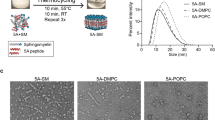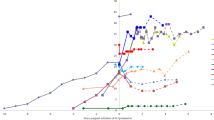Abstract
Niemann-Pick type C disease is an inherited autosomal recessive neurodegenerative disorder characterised by the accumulation of unesterified cholesterol and sphingolipids within the endosomal/lysosomal compartments. It has been observed that the administration of hydroxypropyl-β-cyclodextrin (HPBCD) delays onset of clinical symptoms and reduces accumulation of cholesterol and gangliosides within neuronal cells. It was assumed that HPBCD exerts its action by readily entering the CNS and directly interacting with neurones and other brain cells to facilitate removal of stored cholesterol from the late endosomal/lysosomal compartment. Here, we present evidence that refutes this hypothesis. We use two well established techniques for accurately measuring brain uptake of solutes from blood and show that there is no significant crossing of HPBCD into the brain. The two techniques are brain in situ perfusion and intraperitoneal injection followed by multi-time-point regression analysis. Neither study demonstrates significant, time-dependent uptake of HPBCD in either adult or neonatal mice. However, the volume of distribution available to HPBCD (0.113 ± 0.010 ml/g) exceeds the accepted values for plasma and vascular volume of the brain. In fact, it is nearly three times larger than that for sucrose (0.039 ± 0.006 ml/g). We propose that this indicates cell surface binding of HPBCD to the endothelium of the cerebral vasculature and may provide a mechanism for the mobilisation and clearance of cholesterol from the CNS.





Similar content being viewed by others
References
Aqul AA, Liu B, Ramirez CM et al (2011) Unesterified cholesterol accumulation in late endosomes/lysosomes causes neurodegeneration and is prevented by driving cholesterol export from this compartment. J Neuroscience 31:9404–9413
Atger VM, de la Llera MM, Stoudt GW, Rodrigueza WV, Phillips MC, Rothblat GH (1997) Cyclodextrins as catalysts for the removal of cholesterol from macrophage foam cells. J Clin Invest 99:773–780
Begley DJ (1999) Methods for determining CNS drug transport in animals. In: Paulson O, Moos-Knudsen G, Moos T (eds) Brain barrier systems. Alfred Benzon symposium 45. Munksgaard, Copenhagen, pp 91–109
Begley DJ (2012) Brain superhighways. Sci Transl Med 4:147fs29
Camargo F, Erickson RP, Garver WS, Hossain GS, Carbone PN, Heidenreich RA, Blanchard J (2001) Cyclodextrins in the treatment of a mouse model of Niemann-Pick C disease. Life Sci 70:131–142
Chen FW, Gordon RE, Ioannou YA (2010) Cyclodextrin induces calcium-dependent lysosomal exocytosis. PLoS One 5:e15054
Davidson CD, Ali NF, Micseyi MC et al (2009) Chronic cyclodextrin treatment of murine Nieman-Pick C disease ameliorates neuronal cholesterol and glycosphingolipid storage and disease progression. PLoS One 4:e6951
Dodzuik H (2006) Molecules with holes- cyclodextrins. In: Dodzuik H (ed) Cyclodextrins and their complexes. Wiley-VCH, Weinheim, pp 1–30
Griffin LD, Gong W, Verot L, Mellon SH (2004) Niemann-Pick type C disease involves disrupted neurosteriodogenesis and responds to allopregnanalone. Nat Med 10:704–711
Kilsdonk EPC, Yancey PG, Stoudt GW, Bangertert FW, Johnson WJ, Phillips MC, Rothblat GH (1995) Cellular cholesterol efflux mediated by cyclodextrins. J Biol Chem 270:17250–17256
Liu B, Turley SD, Burns DK, Miller AM, Repa JJ, Dietschy JM (2009) Reversal of defective lysosomal transport in NPC disease ameliorates liver dysfunction and neurodegeneration in the npc1−/− mouse. Proc Natl Acad Sci USA 106:2377–2382
Monnaert V, Betbeder D, Fenart L et al (2004a) Effects of γ-and hydroxypropyl-γ-cyclodextrins on the transport of doxorubicin across an in vitro model of the blood–brain barrier. J Pharm Exp Ther 311:1115–1120
Monnaert V, Tilloy S, Bricout H, Fenart L, Cecchelli R, Monfiler E (2004b) Behaviour of α-, β- and γ-cyclodextrins and their derivatives on an in vitro model of blood brain barrier. J Pharm Exp Ther 310:745–751
Nieuwdorp M, Meuwese MC, Mooij HL et al (2008) Measuring endothelial glycocalyx dimensions in humans: a potential novel tool to monitor vascular vulnerability. J Appl Physiol 104:845–852
Ohtsuki S, Ito S, Matsuda A, Hori S, Abe T, Terasaki T (2007) Brain-to-blood elimination of 24S-hydroxycholesterol from rat brain is mediated by organic anion transporting polypeptide 2 (oatp2) at the blood–brain barrier. J Neurochem 103:1430–1438
Patterson MC, Vanier MT, Suzuki K et al (2001) Niemann-Pick disease type C: a lipid trafficking disorder. In: Scriver CR, Beaudet AL, Sly WS, Valle D (eds) The metabolic & molecular bases of inherited disease, vol. 3, 8th edn. McGraw-Hill Medical Publishing Division, New York, pp 3611–3633
Pentchev PG, Comley ME, Kruth HS, Vanier MT, Wegner DA, Patel S, Brady RO (1985) A defect in cholesterol esterification in Niemann-Pick disease (type C) patients. PNAS USA 82:8247–8251
Plazzo AP, Höfer CT, Jicsinszky L et al (2012) Uptake of a fluorescent methyl-β-cyclodextrin via clathrin-dependent endocytosis. Chem Phys Lipids 165:505–511
Rosenbaum AI, Zhang G, Warren JD, Mayfield FR (2010) Endocytosis of beta-cyclodextrins is responsible for cholesterol reduction in Niemann-Pick type C mutant cells. Proc Natl Acad Sci USA 107:5477–5482
Saunders N, Habgood MP, Dziegielewska KM (1999) Barrier mechanisms in the brain. II. Immature brain. Clin Exp Pharmacol Physiol 26:85–91
Smith QR (2003) A review of blood–brain barrier transport techniques. In: Nag S (ed) The blood–brain barrier biology and research protocols. Humana Press, Totowa, pp 193–208
Smith QR, Ziylan YZ, Robinson PJ, Rapoport SI (1988) Kinetics and distribution volumes for tracers of different sizes in the brain plasma space. Brain Res 462:1–9
Szejtli J (1998) Introduction and general overview of cyclodextrin chemistry. Chem Rev 98:1743–1753
Taylor AM, Liu B, Mari Y, Liu B, Repa JJ (2012) Cyclodextrin mediates rapid changes in lipid balance in Npc−/− mice without carrying cholesterol through the bloodstream. J Lipid Res 53:2331–2342
Urayama A, Grubb JH, Sly WS, Banks WA (2004) Developmentally regulated mannose 6-phosphate receptor-mediated transport of a lysosomal enzyme across the blood–brain barrier. Proc Natl Acad Sci USA 101:12658–12663
Van den Berg BM, Nieuwdorp M, Stroes ESG, Vink H (2006) Glycocalyx and endothelial (dys) function: from mice to men. Pharmacol Rep 58(suppl):75–80
Walkley SU, Suzuki K (2004) Consequences of NPC1 and NPC2 loss of function in neurons. Biochem Biophys Acta 1685:16026–16034
Ward S, O’Donnell P, Fernanadez S, Vite CH (2010) 2-hydroxypropyl-β-cyclodextrin raises hearing threshold in normal cats and in cats with Niemann-Pick type C disease. Ped Res 68:52–56
Yancey PG, Rodrigueza WV, Kilsdonk EPC, Stoudt GW, Johnson WJ, Phillips MC, Rothblat GH (1996) Cellular cholesterol efflux mediated by cyclodextrins. J Biol Chem 271:16026–16034
Acknowledgments
This work was supported by a research grant from The Hadley Hope Fund and The Addi and Cassi Fund. The generation and genotyping of the Npc1 −/− mice was funded by a grant to FMP from SOAR-NPC. Contributions made by SW and CD were made possible through funding by NIH (NS053677). The authors would also like to thank Dr. William Sly and members of his lab at the Edward A. Doisy Department of Biochemistry and Molecular Medicine, St. Louis School of Medicine, St. Louis, MO, USA who have contributed useful critical comments.
Take Home Message
2-hydroxypropyl-ß-cyclodextrin displays no significant time-dependent crossing of the blood-brain barrier in wild type Npc1+/+, wild type neonate Npc1+/+ (P7) or Niemann-Pick C Npc-/- disease mice.
Conflict of interest
None.
Author information
Authors and Affiliations
Corresponding author
Additional information
Communicated by: Maurizio Scarpa
Rights and permissions
About this article
Cite this article
Pontikis, C.C., Davidson, C.D., Walkley, S.U. et al. Cyclodextrin alleviates neuronal storage of cholesterol in Niemann-Pick C disease without evidence of detectable blood–brain barrier permeability. J Inherit Metab Dis 36, 491–498 (2013). https://doi.org/10.1007/s10545-012-9583-x
Received:
Revised:
Accepted:
Published:
Issue Date:
DOI: https://doi.org/10.1007/s10545-012-9583-x




